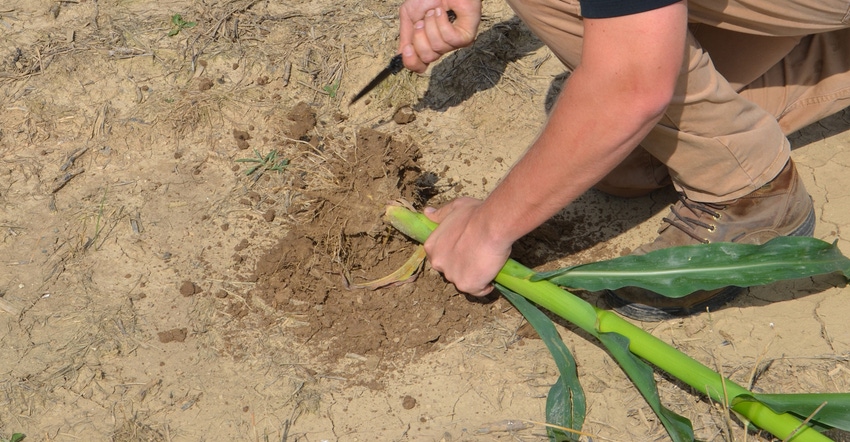
Craig Unverferth dug up two corn plants on a farm near Union City, Ohio. One had very different root patterns. Why?
“One is from planter passes where downforce was set correctly,” explains Unverferth, field product specialist for Agco. “The other was from passes where we purposely put more pressure than necessary on row units. Roots are having trouble penetrating the soil and showing signs of soil compaction.”
This is just one of several demonstrations in the 40-acre cornfield. Unverferth and Derek Reusser, an Agco product specialist, cooperated with the farmer to plant plots where some settings weren’t ideal on purpose. The idea is to show farmers what happens when the planter isn’t set correctly, and planter performance is not monitored carefully enough.
Ohio plots
The plots in Ohio were planted by the farmer using his White 9816 VE planter with Precision Planting’s vSet 2 seed meters and DeltaForce downforce control system. Agco acquired Precision Planting in 2017.
Applying extra downforce on some passes and correct pressure on adjacent passes is only one of the demonstrations at this site, Unverferth says.
“There are passes where we applied light pressure,” he says. “It wasn’t sufficient to get good seed-to-soil contact everywhere. You can find smaller, shorter plants amongst normal plants. They will act like weeds.”
Reusser adds, “You have to get into the field to see these things. You can’t tell it just looking at the field from the road.”
The pair devoted one section to testing seeding depth. They included settings from 1 inch to more than 3 inches. “We’ve found some smaller plants which emerged later where the depth was 1 inch,” Unverferth notes. “It’s likely those seeds didn’t get into moisture and waited for rain.”
In another section they installed “goof disks” in the meters on certain rows. “Singulation dropped to about 96%, when we can usually get 99% or better,” Unverferth says. “We’ve found in past years working with plots that a 1% drop in singulation can cost you a bushel per acre, maybe more.”
After installing the goof disks, they did a section where they repeated the down-pressure demonstration. Next, they ran rows with and without Keeton seed firmers to see if there will be a difference in stand uniformity and yield.
In other parts of the field, they ran passes at 5 and 10 miles per hour. Some people are planting at up to 10 mph today, but usually only after they install special speed tubes available from Precision Planting and other companies. This planter wasn’t equipped with speed tubes.
Plot tours
You can see the effects of different planter settings yourself on Aug. 14. Agco will hold a plot tour at the Union City location, near the Indiana-Ohio border.
The plot is just one of several locations where similar demonstrations are underway. Tours will be held at these locations, as well: Arthur, Ill.; Gladbrook, Iowa; Irwin, Iowa; Morning Sun, Iowa; Falls City, Neb.; Fremont, Neb.; Hankinson, N.D.; and Wausau, Wis.
For exact tour locations, dates and times, visit a Challenger, Massey Ferguson or Precision Planting dealer, or agcocorp.com. You can also visit the Crop Care section of myfarmlife.com, or follow Agco Crop Tour on Facebook or on Twitter at #agcocroptour.
About the Author(s)
You May Also Like




